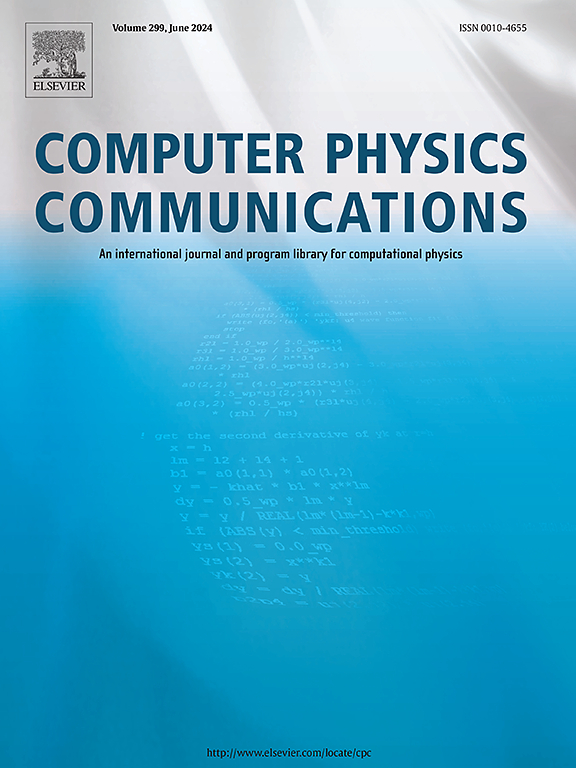ANEMONE:固态电空气动力推进系统的三维模拟框架
IF 3.4
2区 物理与天体物理
Q1 COMPUTER SCIENCE, INTERDISCIPLINARY APPLICATIONS
引用次数: 0
摘要
固体电气动推进系统是利用大气压电晕放电的装置,近年来作为实现无人机静音的一种手段得到了积极的研究。然而,这些系统包含多个,广泛不同的时间和空间尺度。因此,系统的控制方程,一个考虑电子、正离子和负离子存在的三组分等离子体流体模型,构成了一个僵硬的非线性偏微分方程系统,具有挑战性。在这里,我们开发了一个ANEMONE模拟器,能够数值估计三维固态电气动推进系统的电晕起始电压和能量转换效率。具体而言,在控制方程的基础上,采用特征法和摄动法求解子问题。此外,我们成功地得到了积分方程,使子问题更容易求解。最后,根据前人研究的理论结果对预测结果进行验证。值得注意的是,ANEMONE是世界上第一个能够预测全三维推进系统的两个代表性性能(即电晕起始电压和能量转换效率)的模拟器。程序摘要程序标题:ANEMONECPC库链接到程序文件:https://doi.org/10.17632/2sxsg2pmyp.1Licensing条款:麻省理工学院编程语言:c++问题的性质:固态电-空气动力推进系统[1]电离环境空气,可以推动静音无人机。对于系统的快速成型,重要的是利用数值模拟,但系统的时空尺度是多样的;因此,相应的控制方程(例如可以同时考虑电子、正离子和负离子的三组分等离子体流体模型)过于僵硬而无法求解。例如,系统的整体空间尺度为米级,而电极的尺度为微米级。此外,离子在电极之间的移动以毫秒为单位,而麦克斯韦介电弛豫时间尺度为纳秒。求解方法:对于空间尺度问题,我们采用了三维层次笛卡尔网格法和自适应网格细化法。同时,实现了网格的全自动生成,保证了网格的收敛性。对于时间尺度问题,我们采用了微扰法[2]和特征法相结合的方法。这样可以将原问题分解为许多易于求解的子问题。[10]徐浩峰等,固体推进飞机的飞行,自然科学,563(7732)(2018)532-535。[10]柴田久一,等,基于微扰法的电流体动力推进器性能预测,物理学报。等离子体23(5)(2016)。本文章由计算机程序翻译,如有差异,请以英文原文为准。
ANEMONE: A framework for three-dimensional simulations of solid-state electroaerodynamic propulsion systems
Solid-state electro-aerodynamic propulsion systems are devices that utilize atmospheric pressure corona discharge and have been actively researched in recent years as a means of achieving silent drones. However, these systems contain multiple, widely disparate time and spatial scales. Therefore, the governing equations of the systems, a three-component plasma fluid model that considers the presence of electrons, positive ions, and negative ions, constitute a stiff non-linear system of partial differential equations, challenging to solve. Here, we have developed an ANEMONE simulator capable of numerically estimating the corona inception voltage and energy conversion efficiency in three-dimensional solid-state electro-aerodynamic propulsion systems. Specifically, on the basis of the governing equations, we adopted the method of characteristics and the perturbation method to obtain the sub-problems. Furthermore, we have successfully obtained the integral equations, making the sub-problems easier to solve. Finally, we validated the prediction results based on the theoretical results in a previous study. Remarkably, ANEMONE is the first simulator in the world which predicted the two representative performance (i.e., the corona inception voltage and energy conversion efficiency) of fully three-dimensional propulsion systems.
Program summary
Program Title: ANEMONE
CPC Library link to program files: https://doi.org/10.17632/2sxsg2pmyp.1
Licensing provisions: MIT
Programming language: C++
Nature of problem: Solid-state electro-aerodynamic propulsion system [1] ionizes the ambient air and can propel silent drones. For the rapid-prototyping of the system, it is important to utilize numerical simulation, but the spatial and temporal scales of the system are diverse; hence, the corresponding governing equations (e.g. the three-component plasma fluid model which can simultaneously consider electrons, positive and negative ions) are too stiff to solve. For example, the overall spatial scale of the system is the order of meters, while the scale of the electrodes is the order of micrometers. Moreover, the ions move between electrodes in the order of milliseconds, while the Maxwell dielectric relaxation time scale is in the order of nanoseconds.
Solution method: For the issue of the spatial scales, we adopt a three-dimensional hierarchical Cartesian grid method together with the adaptive mesh refinement method. Moreover, this leads fully automatic mesh generation and ensures the grid convergence. For the issue of the temporal scales, we adopt the perturbation method [2] combined with the method of characteristics. This can decompose the original problem into many subproblems easy to solve.
References
- [1]Haofeng Xu, et al., Flight of an aeroplane with solid-state propulsion, Nature 563 (7732) (2018) 532–535.
- [2]Hisaichi Shibata, et al., Performance prediction of electrohydrodynamic thrusters by the perturbation method, Phys. Plasmas 23 (5) (2016).
求助全文
通过发布文献求助,成功后即可免费获取论文全文。
去求助
来源期刊

Computer Physics Communications
物理-计算机:跨学科应用
CiteScore
12.10
自引率
3.20%
发文量
287
审稿时长
5.3 months
期刊介绍:
The focus of CPC is on contemporary computational methods and techniques and their implementation, the effectiveness of which will normally be evidenced by the author(s) within the context of a substantive problem in physics. Within this setting CPC publishes two types of paper.
Computer Programs in Physics (CPiP)
These papers describe significant computer programs to be archived in the CPC Program Library which is held in the Mendeley Data repository. The submitted software must be covered by an approved open source licence. Papers and associated computer programs that address a problem of contemporary interest in physics that cannot be solved by current software are particularly encouraged.
Computational Physics Papers (CP)
These are research papers in, but are not limited to, the following themes across computational physics and related disciplines.
mathematical and numerical methods and algorithms;
computational models including those associated with the design, control and analysis of experiments; and
algebraic computation.
Each will normally include software implementation and performance details. The software implementation should, ideally, be available via GitHub, Zenodo or an institutional repository.In addition, research papers on the impact of advanced computer architecture and special purpose computers on computing in the physical sciences and software topics related to, and of importance in, the physical sciences may be considered.
 求助内容:
求助内容: 应助结果提醒方式:
应助结果提醒方式:


